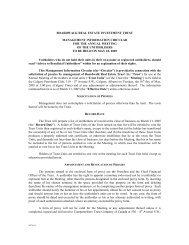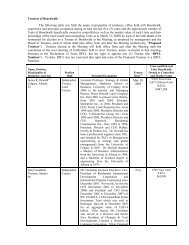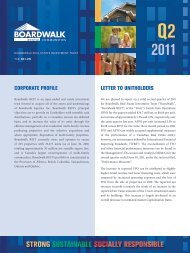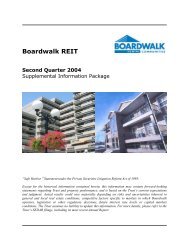BMO Financial Group - Outlook 2005(1.1Mb pdf File) - Boardwalk REIT
BMO Financial Group - Outlook 2005(1.1Mb pdf File) - Boardwalk REIT
BMO Financial Group - Outlook 2005(1.1Mb pdf File) - Boardwalk REIT
You also want an ePaper? Increase the reach of your titles
YUMPU automatically turns print PDFs into web optimized ePapers that Google loves.
22<br />
Residential construction has been robust in<br />
Manitoba recently, with housing starts<br />
estimated to hit 4,400 in 2004 – the highest<br />
level in 16 years. Starts are projected to taper<br />
off in <strong>2005</strong> but remain relatively high at 3,600<br />
units. Non-residential construction should be<br />
supported in <strong>2005</strong> by a number of large<br />
projects, including the $660 million expansion<br />
of the Red River Floodway.<br />
After a poor performance in 2003, we expect<br />
the manufacturing sector to make substantial<br />
gains in 2004 and <strong>2005</strong>. In particular, the<br />
province’s two largest manufacturing export<br />
categories (food and transportation equipment)<br />
are set for strong growth. Food processing<br />
should grow smartly, thanks to continued<br />
improvements in agricultural production and<br />
relatively strong US demand. Transportation<br />
equipment manufacturing (mostly airplanes and<br />
buses) should improve as the North American<br />
travel outlook brightens and many US cities<br />
upgrade their bus fleets.<br />
Agricultural prospects also look encouraging as<br />
soil moisture conditions have continued to<br />
improve following the 2001-02 drought.<br />
Reflecting higher prices, farm cash receipts<br />
have risen solidly in 2004. Our forecast<br />
assumes average crop yields in both 2004 and<br />
<strong>2005</strong>.<br />
Hydroelectric production has rebounded in<br />
2004, after low water levels reduced output in<br />
2003. Water flows are now above normal,<br />
which will result in ongoing strength in hydro<br />
sales. Longer term, the outlook for hydro looks<br />
bright. The province is examining a number of<br />
hydroelectric developments that would result in<br />
increased sales to Ontario and Saskatchewan.<br />
Public sector restraint will weigh on the<br />
economy this year and next. On a<br />
consolidated basis, the 2003-04 deficit hit $531<br />
million, largely due to the poor performance of<br />
Manitoba Hydro, which in turn was a result of<br />
the low water flows mentioned earlier. For<br />
2004-05, the government budgeted for the<br />
deficit to fall to $58 million, thanks to fiscal<br />
restraint and an expected improvement at<br />
Manitoba Hydro. Four hundred civil service<br />
positions will be cut and base program<br />
spending is to rise only 1.4%. While program<br />
spending is budgeted to rise at a somewhat<br />
faster pace in <strong>2005</strong>-06 (2.6%), it would remain<br />
well below the rate of nominal GDP growth.<br />
Labour market conditions have been rather<br />
tepid in 2004, with sluggish employment and a<br />
modest upward tilt to the jobless rate.<br />
Nevertheless, at a projected 5.2% for 2004 as<br />
a whole, the jobless rate in Manitoba would be<br />
second lowest in Canada, after that in Alberta.<br />
Labour earnings growth has been far better<br />
than in Canada as a whole, providing solid<br />
support for consumer spending. Retail sales<br />
are projected to rise by close to 8% in 2004,<br />
almost double the national rate and second<br />
fastest after Alberta. In <strong>2005</strong>, continued solid<br />
growth in employment should reduce the<br />
unemployment rate even further to 5.1%.<br />
Saskatchewan<br />
Saskatchewan posted a healthy increase in<br />
GDP of 4.5% in 2003, thanks to the end of a<br />
two-year drought that had caused crop<br />
production to plummet between 2000 and<br />
2002. Crop output rose substantially (46%) in<br />
2003 to 21.8 million tones, though it remained<br />
below its ten-year average of 23.7 million<br />
tonnes.<br />
Good soil moisture conditions early in the 2004<br />
growing season fostered hopes for a bumper<br />
crop this year. Unfortunately, cool, wet weather<br />
late in the summer and, in some places, early<br />
frost, dashed such expectations.<br />
Saskatchewan Agriculture’s latest crop<br />
production estimate (September 27th) pegged<br />
2004 production at 25 million tones. While<br />
production is above average in quantity, it is<br />
likely be below average in terms of quality.
















